The SCRD has a lot of irons in the fire and wells in the ground, so while it’s pursuing tapping a potentially bounteous aquifer at shíshálh | Sechelt Hospital, the supply to Chapman Water System won’t come to fruition in the next couple of years.
At the May 22 committee of the whole, directors approved a feasibility project to include monitoring, analysis, preliminary design and engagement, for wells at shíshálh | Sechelt Hospital.
The $864,550 and staff resources earmarked for the abandoned Gray Creek intake project was reallocated to the hospital well project. Staff will also bring forward a proposal for further feasibility work as part of next year’s budget process.
Capacity
Preliminary testing earlier this year found “high quality, high groundwater flow, small area of influence and good water quality,” said general manager of infrastructure services Remko Rosenboom. But, as the SCRD is pursuing a water licence to draw 74 liters per second, the feasibility project requires larger wells.
While 74 litres per second is the most they can pull without obtaining a full environmental assessment, based on the initial tests, they predict the well has “a way larger capacity,” said Rosenboom.
The SCRD is working on a rights and title application with shíshálh Nation and a land use agreement with Vancouver Coastal Health, said Rosenboom.
The 2026 budget proposal, to complete production well drilling and testing, staff estimates will be in the $350,000 to $400,000 range. This would support the SCRD in collecting “key technical data” to inform future well field development and long-term water supply planning, said the report.
Feasibility –– and more board approvals –– would need to be confirmed before full design and construction work for a well field could proceed, according to the report.
Dusty Road connection?
West Howe Sound director Kate Stamford asked about the relationship between this hospital well and the Dusty Road well, which the SCRD abandoned as a potable water source.
“Dusty Road well is located within the same aquifer, as we currently see it,” said Rosenboom. However, an aquifer is not one uniform body of water, he stressed. Using the example of Aquifer 560, which supplies all of the Town of Gibsons, as well as the Church Road Well Field, Rosenboom said the aquifer has one recharge area but consists of several “lobes” that aren’t connected.
“I think the aquifer that we're currently dealing with is similar. There's no connection between the water that's flowing towards Dusty and the water that's flowing towards this well,” said Rosenboom. There may not even be a connection between the hospital well and some of the Heidelberg wells, as there may be a rock formation between the two, suggested Rosenboom.
Directors weigh in
Sechelt director Alton Toth questioned the recommendation to have staff come forward with a budget request for 2026. “We've got a ton of stuff in the hopper. And I don't want to signal that this is going to be something that's going to be done and dusted next year,” said Toth. “It is going to be a long process.”
Speaking in favour of moving ahead with a 2026 budget request, shíshálh Nation director Phillip Paul cautioned that there could be more negatives to come –– the aquifer being below sea level and risking saltwater intrusion, a slow-recharging aquifer and other hurdles.
He noted the area around the hospital is deep, sandy material, “So that would subside very easily” and brought up the question of sinkholes.
“We don't know enough –– that's what the testing provides us,” he said. “We need to plan and budget as if this well was going forward.”
Rosenboom later elaborated that the province would not license a well that could result in saltwater intrusion, and they would consider climate change in that assessment. He said “there are a lot of safeguards in place,” as well in terms of impact to land or subsidence.
Paul also noted it was his impression when the proposal was brought to the Nation, that the well was going to be “emergency water for the hospital, not production service for the entire Coast,” and that’s what their conversations with VCH had been.
Rosenboom said this would be a production well connected to the Chapman Water System, and that VCH is interested in the well as it “would provide them with more than enough water to provide [for] the entire hospital [in an] emergency situation, even if the entire system would go down.”
“I'm full speed ahead on water,” said Sechelt director Darren Inkster. “That's why I'm supporting the shíshálh on their reservoirs, wherever they may be. I'm pushing the wells if we can get them done. And I'm supportive of any other water projects, including the metering to save water.”
The motions passed unanimously. They still need to be confirmed at the board level.



